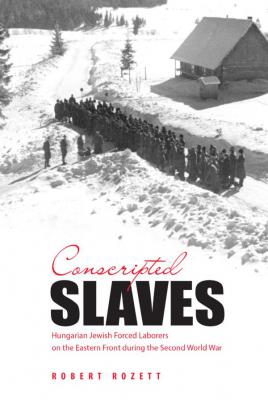For the vast majority of Hungarian Jews, their family history includes the story of their fathers, sons, brothers and husbands who were drafted into the Labor Service to perform forced labor during the Holocaust. A large percentage of Jewish Labor Service draftees (some 45,000 out of about 100,000) were sent with the Hungarian Second Army to the occupied territories of the Soviet Union, primarily from spring 1942 until the summer 1944. Subjected to grinding brutality on the front, the Jewish forced laborers’ suffering was often increased exponentially by the treatment they received at the hands of the Hungarian officers and soldiers who controlled their lives. Some 80% of the Jewish forced laborers never returned home, falling prey to battle, disease, Soviet captivity and outright murder at hands of Hungarian soldiers.
The thrust of this book is the attempt to tell the story of the men of the Labor Service from eye level, although it also sets out the establishment of the Labor Service System, the attitudes of those who set it up and ran it toward the Jewish forced laborers, and their behavior toward them. But mostly, it seeks to convey what the laborers themselves were undergoing and as much as possible, what they were thinking and how they were responding.
The main documentary basis for this monograph is personal accounts – testimonies and memoirs, and a few diaries and letters, of those who endured. These personal accounts were supplemented by a unique set of documents from the war itself that is held by Yad Vashem. The Hungarian Military’s card index of casualties among the forced laborers on the Eastern Front, with varying degrees of detail about those who fell, was an integral instrument for corroborating information gleaned from personal accounts and for adding details and statistics.
Bound up in the saga of the Hungarian Jewish forced laborers on the Eastern Front are nearly unimaginable, gratuitous hatred and cruelty, interspaced with occasional humanity and even heroism. The laborers were made to work very hard in generally exacting conditions and frequently with the cruel harassment of the Hungarian officers and soldiers in charge of them. Even work like cutting trees could be made to be terrible when the men had to run many kilometers with the freshly cut wood on their shoulders, run back, and do it all over again several times in a given day, all the while being subjected to curses and blows. Some jobs were simply dangerous, such as burying the dead on the forward lines without any kind of protection while bullets from both sides of the lines flew past the forced laborers. Other jobs were outright murderous, like clearing mine fields without previous training and wielding only sticks to dig out mines that were discovered. The underlying idea was that the men would reveal mines by stepping on them, with the obvious consequences to life and limb.
As cruel as their treatment was in general, there were exceptions. A few Hungarian soldiers and officials did their best to help the forced laborers, treating them like human beings and trying to better the conditions of their service. Among them several have been recognized as Righteous Among the Nations.
The forced laborers were direct and indirect witnesses to the destruction of the Jews in the areas in which they were stationed. Yet despite this and their own suffering, they did not usually see themselves as part of the unfolding Holocaust. Still they were not simply passive participants in events. At times they tried to help local Jews they encountered, especially early in their service, by giving them food. They sometimes banded together to help each other within their companies as a whole, or in smaller support groups. A few sought to escape to the local partisans, but unfamiliarity with the terrain and language, as well as the expected punishment for failure, deterred most from following this path. When Soviet forces drew near, many intentionally became prisoners of war, hoping their trials and tribulations would soon end. The Soviets, however, regarded them as Hungarian soldiers and as result they entered the Soviet prisoner of war system. Tragically only about a quarter of those who became prisoners survived.
The Labor Service System was not set up to be an instrument of torture and murder. It was meant to be a framework for those who were considered unworthy of bearing arms to serve the Hungarian nation in time of war. By the time Hungary became fully involved in World War II, however, Jews had been defined as unworthy of being regular soldiers. In the crucible of the war, with rampant antisemitism in Hungarian society as a whole, and particularly in the military, forced labor for Jews on the Eastern Front became lethal for the great majority.
Unlike the industrialized, dehumanized, anonymous murder we associate with the extermination camps that has become the paradigm for the Holocaust, the story of the Hungarian Jewish forced laborers on the Eastern Front is a tale of intimates. The men of the Labor Service sometimes knew one another before the war, and the great majority, in the crucible of the war, spent intensive weeks, months and even years together in the same company. In other words, the victims were not merely abstract constructs to the perpetrators – the “other” - but real people. This intimacy raises many issues regarding the nature of the Shoah, the responsibility of the perpetrators and their society, how one can be an intimate and an “other” at the same time, and why we must strive to create societies in which there are no “others.”
To purchase the book click here >







